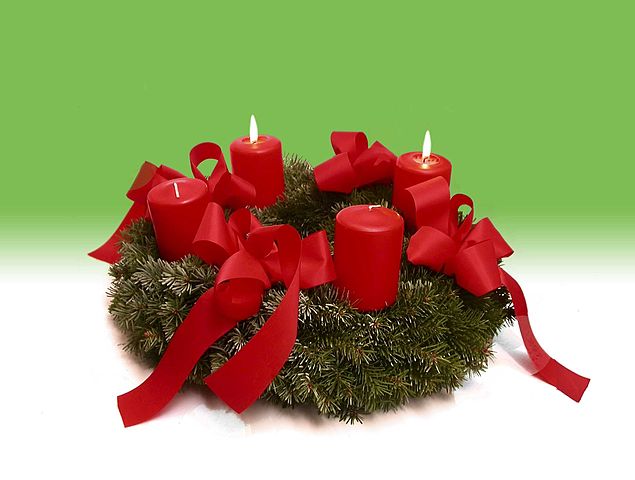As we head into the weekend, here is some Christmas cheer from The Muppets. Enjoy.
Tag Archives: Christmas
Advent (2nd Sunday)
Today is the Feast of St. Nicholas-The Real Santa Claus (6 Dec)
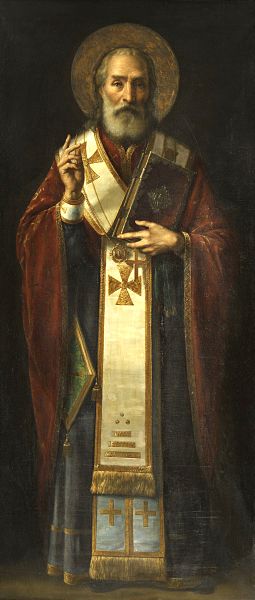
Public Domain
Today is the feast of St. Nicholas, the basis for what has become known as Santa Claus. He was born in the third century to a wealthy family in the village of Patara (now located on the southern coast of Turkey). At the time the area was mostly Greek. While he was young, his parents died during an epidemic. Raised as a Christian, he believed in obeying Jesus in giving his inheritance to those in need. He dedicated his life to serving God and was made Bishop of Myra was still quite young. He earned a reputation for being generous to those in need, his love for children, and concern for sailors and ships.
During the rule of the Roman Emperor Diocletian, Christians were ruthlessly persecuted, and Nicholas suffered for his faith by being exiled and imprisoned. Despite all of the hardship he endured, he never wavered in his faith. He was released and attended the Council of Nicaea in 325 AD. He died on 6 December 343 AD in Myra and was buried. The anniversary of his death would become a celebration and still celebrated to this day (it is 19 December on the Julian calendar used by Eastern Orthodox churches).
His generous deeds and miracles attributed to him spread during the Middle Ages. Many sailors claimed him as a patron and told of him when they traveled. Churches dedicated to Nicholas appeared in many seaport cities. His name spread both east and west making him a very popular saint with many churches named after him in Austria, Belgium, England, Italy, Russia, and Switzerland to name a few. His tomb became popular to visit but concerns over wars in the area cutting off access worried many. In 1087 sailors from Bari were able to retrieve his relics and bring them back. A church was built over his crypt so that pilgrims could visit. The shrine to St. Nicholas in Bari became a major pilgrimage center during medieval Europe. People still visit the shrine today at the Basilica di San Nicola in Bari.
The Roman Catholic Church, Eastern Orthodox, Greek Orthodox, Anglican, and Lutheran churches all have his feast day on their calendars. His generosity and compassion are seen as a model of Christian life. There is some confusion generated about how saint feasts days are celebrated in the Catholic church. Since there quite a number of saints with feasts, it was decided that some saint feast days would be optional for a diocese to celebrate. Saint Nicholas became one of them. He was not stripped of his sainthood. In a diocese where he is popular, has churches or schools named after him, or perhaps the bishop believes he is model to be held up for veneration, his feast day will be celebrated. His feast day is celebrated throughout Europe and in Russia and children receive gifts on the day. Saint Nicholas’ feast day is usually the start of the Christmas season in Europe and elsewhere.
Saint Nicholas and Santa Claus
Saint Nicholas did not fare well during the Protestant Reformation. Saints, even revered ones, were removed to focus on Jesus. Some went so far as to nearly ban any public display of traditional religious customs related to saints or even Christmas (it was not a holiday for that reason in areas that groups like the Puritans dominated). Martin Luther wanted to shift the focus of Christmas to Jesus. The problem was that you cannot have a baby delivering gifts to children as Saint Nicholas did. He came up with the Christkind, a children’s gift giver. This angel, depicted as young girl, brings the gifts when the children are not present. In Nuremberg, the Christkind is selected every two years by vote and between the ages of 16-19. The Christkind opens the Christmas market. She also has her picture taken with kids, listens to what they want, visits kids in hospitals and the elderly as well amongst many other duties. The Christkind was also adopted by many German Catholics as well and spread into Latin America as well. In some cases, both the Christkind and Saint Nicholas deliver presents together.
Despite attempts to diminish Saint Nicholas using the Christkind, he remained popular except in England where many Christmas folk traditions were altered (especially under the rule of the Puritans and Oliver Cromwell). Puritans in America (and some others as well) forbade celebrating Christmas. German immigrants brought celebrating Christmas with them along with Saint Nicholas as well. It was believed the Dutch had brought Saint Nicholas to America, but recent scholarship indicates that was not likely (it is not mentioned in letters or records from the Dutch who lived in New Amsterdam at the time). It appears a series of fictional stories about Saint Nicholas (described as a jolly man with a clay piper) being celebrated by the early Dutch may have been the source.
The 19th century was one of change in America regarding Christmas-and elsewhere as well. Since it was not a sacred or public holiday in many places, it was not the time of carols and goodwill we think about today. Instead, it was a was a rowdy holiday where many got wildly drunk, gambled, and got riotous in some cases threatening people. In England, the Father Christmas figure was about adult merriment and feasting and had nothing to do with children. The actual celebration of Christmas seemed to be fading until books were published depicting Christmas as a time for family, children and faith were published in the 19th century. Washington Irving’s The Sketchbook of Geoffrey Crayon (1819) depicted the celebration of Christmas in England as a warm holiday where peasants were invited into the home to celebrate the holiday. And stories about a magical gift giver called Sante Claus began to appear. Books such as The Children’s Friend (1821) had a character delivering gifts to children on Christmas Eve. Flying a sleigh and living up north, this Sante Claus would form the basis of what is known today as Santa
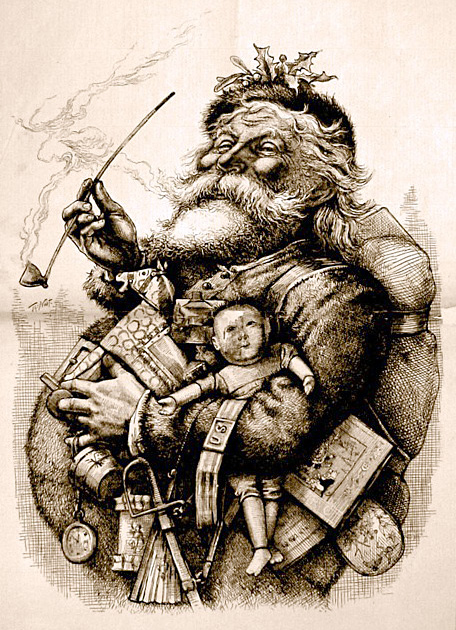
Thomas Nast, 1881
Public Domain
The famous Clement Clark Moore poem A Visit from St. Nicholas would further cement the image of this Sante Claus. Books depicting Christmas began to appear and of course the most famous being A Christmas Carol by Charles Dickens in 1843. This came at a time in Britain when they were re-examining Christmas. This book and others would further help to make Christmas as a time for families, children, and caring about the less fortunate as well. Thomas Nast, the famous political cartoonist, illustrated him as a rotund figure with a beard, fur clothing, and with a clay pipe in 1863. He also changed the name to Santa Claus. His image, with some embellishments and refinements, has remained more or less intact to our time. Christmas was becoming widely celebrated and by 1860 had already been adopted as a state holiday in fourteen states. In 1870, President Grant proclaimed Christmas Day as a federal holiday in the District of Columbia. Congress would pass legislation that made Christmas, New Years, Independence Day and Thanksgiving as federal holidays (remember back then nearly all federal workers were in the District of Columbia). States would also make it a holiday as well.
By the start of the 1930’s, the American Santa had come full form thanks to various illustrators such as Norman Rockwell. Coca-Cola would use Santa in its advertising further establishing his identity in the commercial world. The jolly man with the red suit would be seen in magazines, billboards, shop counters, and greeting cards. A benign source of happiness and seemingly endorsing all kinds of commercial products, he became as American as apple pie (to coin a phrase). His image would spread out to the world competing with local versions (Father Christmas, Pere Noel, Babbo Natale, Sinter Klass, Julenesse etc.) Saint Nicholas still retains his place in Europe despite this.
Many people, seeing Santa as a commercial and pagan creation, are now reclaiming the saint for use in the holiday. Saint Nicholas brings a spiritual emphasis to the holiday, which Santa does not. Some have tried to ban Santa Claus because of his supposed connection to Saint Nicholas, except there is none. One is a revered saint and bishop, the other a complete concoction of writers, illustrators, and marketing departments. There is nothing Christian about Santa Claus. Movies like The Santa Clause, while entertaining, put him into a world of fantasy beings like Mother Nature, Cupid, and the Tooth Fairy. By returning focus to Saint Nicholas, we get closer to what the celebration is about.
Sources:
“Who is-St. Nicholas?” St. Nicholas Center, www.stnicholascenter.org.
Straus, Jacob. “Federal Holidays: Evolution and Current Practices.” Congressional Research Services, R41990, Congressional Research Services, 1 July 2021, https://fas.org/sgp/crs/misc/R41990.pdf. Accessed 4 Dec. 2023.
“A History of Christmas in America.” The Classical Historian, www.classicalhistorian.com/johns-blog/a-history-of-christmas-in-america.
“History of Christmas – Origins, Traditions and Facts | HISTORY.” HISTORY, 27 Oct. 2009, www.history.com/topics/christmas/history-of-christmas.
Advent (1st Sunday)
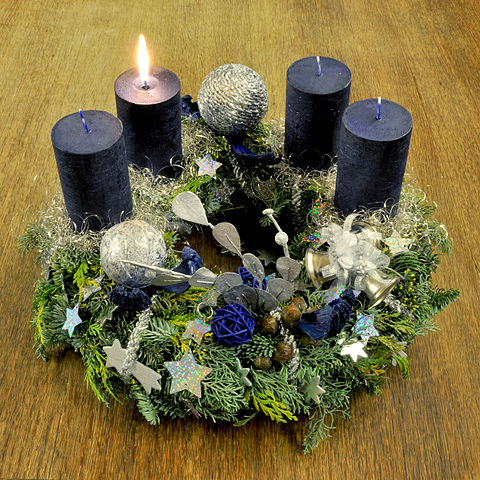
Photo :Micha L. Rieser(Wikimedia Comos)
Advent is not just a countdown till Christmas but an important part of the liturgical year in preparation for the birth of Jesus. Roman Catholics, Eastern Orthodox, Anglicans and other Christian denominations observe this special time. Advent is a short period of only four weeks (Sundays and weekdays) leading up to Christmas Day. Usually, Advent begins on or after the feast of St. Andrew the Apostle on 30 November. Eastern Orthodox uses the Julian calendar for their liturgical year, so they start 13 days after the current Gregorian calendar date.
The word Advent comes Latin word adventus, meaning coming or coming to, is a time of preparation for the birth of Christ and a reminder that Jesus will return. Christians are reminded during this period to not be distracted or weighed down by all the commercialization that is going on around Christmas and focus on deepening their relationships with God. For Catholics it will be solemn masses, setting up Advent wreaths, reciting special prayers, and being more concerned about our fellow human beings. There are also special Advent songs and music that are used during this time as well.
Anglicans uses both traditional and modern rituals which include Advent processions, carols, and using Advent calendars (Catholics are doing this as well). Lutherans focus on God’s grace and his redemption. They incorporate Advent hymns, scripture, and lighting Advent candles as well. For Eastern Orthodox, it involves fasting until Christmas Day, daily prayers, and greatly anticipating the important event that is to come.
Whatever the denomination, Christians are preparing themselves for not only the birth of the savior but his return one day (the Final Judgment). So, it is a time of preparation, repentance, faith, and loving our fellow human beings. It also means to seek reconciliation through prayer and going to a priest or minister to get forgiven for our sins. Advent is not a time of merely counting down the clock and buying presents but spending time preparing for this important holy day that is to come. And a time to get closer to God as well.
Sources
Klein, Camilla. “Which Christian Denominations Celebrate Advent? – Christian Educators Academy.” Christian Educators Academy, 26 May 2023, www.christianeducatorsacademy.com/which-christian-denominations-celebrate-advent.
Infoplease. “Advent: Dates, Traditions, and History.” InfoPlease, 18 Nov. 2021, www.infoplease.com/culture-entertainment/holidays/advent-dates-traditions-and-history.
Staff, CNA. “What Is Advent Anyway?” Catholic News Agency, 1 Dec. 2023, www.catholicnewsagency.com/news/42900/what-is-advent-anyway-a-cna-explainer.
—. “The Beautiful Meaning and Purpose of Advent.” Crosswalk.com, 13 Nov. 2023, www.crosswalk.com/special-coverage/christmas-and-advent/the-beautiful-meaning-and-purpose-of-advent.html.
Welcome to December
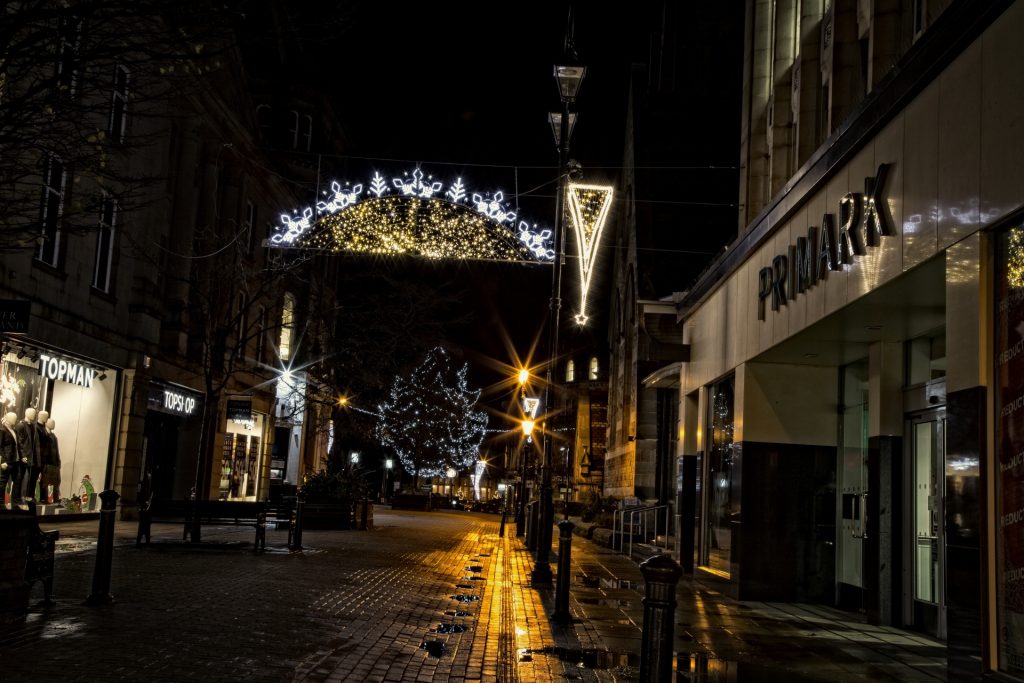
George Hodan, publicdomainpictures.net
December is the 12th month on the Gregorian calendar. The name derives from the Latin word decem, which means ten. Originally December was the tenth month in an older calendar as it started in March. Apparently the winter days that followed December were not included in a month until much later when January and February were added. December retained its name though. Anglo-Saxons used the term Yule for December-January, but that now that has largely come to mean December and the Christmas season.
December has the winter solstice in the Northern Hemisphere and the summer solstice in the Southern. Winter traditionally begins on the astronomical calendar around 21 December or the date of the actual solstice. The winter solstice is the shortest day of the year and depending on how far north you live, sunlight may only be for a few hours on that day. The symbols for December are the narcissus flower and turquoise, zircon and tanzanite as the birthstones.
Most Christians celebrate Advent in preparation for the celebration of Christmas on 25 December. Jews celebrate Chanukah/Hanukkah, the 8-day Festival of Lights in December as well. Kwanzaa is celebrated from December 26-January 1.
Today is Epiphany Sunday

Photo: Public Domain (This media file is in the public domain in the United States. This applies to U.S. works where the copyright has expired, often because its first publication occurred prior to January 1, 1923.)
We saw his star at its rising and have come to do him homage. (Matthew 2:2)
Epiphany Sunday in most Christian liturgical calendars is celebrated on the nearest Sunday after January 6, the traditional observed day of the Epiphany. The Catholic Church will celebrate if it falls on a Sunday or on a Sunday between January 2 and January 8. Since Eastern Orthodox uses the Julian calendar, it will occur 13 days later. Epiphany or Three Kings Day is to celebrate the arrival of The Magi (Three Kings or Wise Men). During the Middle Ages, this was a major feast day (a solemnity) requiring attendance at church on that day. However as many people had to work it became more difficult to attend, the Catholic Church decided to make it easier for people to attend on Sunday, when most do attend church. Some Protestant churches celebrate the Epiphany season from January 6 till Ash Wednesday.
Today is Christmas Day (Eastern Orthodox)
The Eastern Orthodox Church follows the Julian calendar for its liturgical calendar. So all their major observances (Christmas & Easter) occur 13 days later. Which is why today is Christmas Day in many countries where Orthodox Christians reside. Many of my friends are gathering today to celebrate this special day. So that is why I am reposting Merry Christmas today to wish happiness and joy to my friends in Eastern Orthodox.
==
Titanic News Channel wishes everyone a blessed and joyous Christmas Day. Merry Christmas!
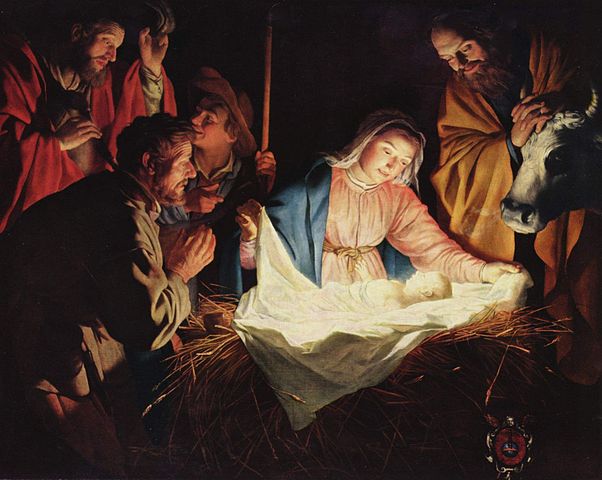
Image: Public Domain (Wikipedia)
….And it was always said of him, that he knew how to keep Christmas well, if any man alive possessed the knowledge. May that be truly said of us, and all of us! And so, as Tiny Tim observed, God Bless Us, Every One!” (Dickens, A Christmas Carol)
Today is Epiphany Day, the Twelfth day of Christmas

El Greco (1541–1614)
Public Domain
Epiphany or Three Kings Day is celebrated on January 6 by most Western Christian denominations. It is the day set aside to celebrate the arrival of the Three Wise Men in Bethlehem and the presentation of their gifts to Jesus. The Catholic Church decided to move its observance to the Sunday after Christmas so people would not have to take off work to attend mass.
Epiphany Day is the twelfth day after Christmas Day and usually concludes the Christmas season. Twelfth Day observances vary by country and some celebrate it on the evening before. Usually there are special celebrations involving foods and special cakes. If a Christmas log was lit for the season, it is now extinguished. King cake (a traditional part of the feast) is almost always present. Children often get gifts of candy or other things from the Wise Men. In Italy, the Christmas Witch La Belfana delivers gifts on Epiphany Eve to stockings children put up before bed. They awake to the delight of treats in the stockings. In Spain, it is celebrated as Dia de los Reyes (Three Kings’ Day) where families gather to celebrate the day.
One good way to celebrate it with the family is to gather before the nativity to remember what the holiday is all about. Christmas music should be played, and a nice midday meal served. Then taking down the Christmas tree can be done together. The nativity scene can remain up until the Baptism of the Lord which ends the Christmas season on the liturgical calendar.
Remembering the Children Killed by King Herod

Matteo di Giovanni (1435–1495)
Public Domain
The Feast of the Holy Innocents or Innocent’s Day (December 28) is to remember the slaughter of male children 2 years and younger in Bethlehem and in its vicinity by Herod the Great. The story as related in the Gospel of Matthew (2:16-18). Herod was angered when the Wise Men did not return to him after locating the Messiah. No one can say with certainty how many were killed. Some have doubted it happened at all, but it would be consistent with Herod the Great’s personality. He had no problems executing even members of his family if he thought they were betraying him. And since Bethlehem was a small area, the slaughter may not have been widely noticed.
Nearly all the Christian churches observe the feast day though not on the same day. The Catholic Church and most western churches observe it on December 28 but Eastern Orthodox celebrates on December 29. The slain children are treated as martyrs of the church. It is not certain when it was first observed. While the exact date of the deaths is unknown, it is kept in the octave of Christmas as it followed the birth of Jesus. However, it is believed it took place sometime after Jesus’s birth. Matthew says the Wise Men saw the child with his mother indicating he was no longer a baby. And Herod had learned from the Wise Men the approximate date of the birth.
Sources:
Today is the Feast of St.Stephen (Boxing Day U.K.)
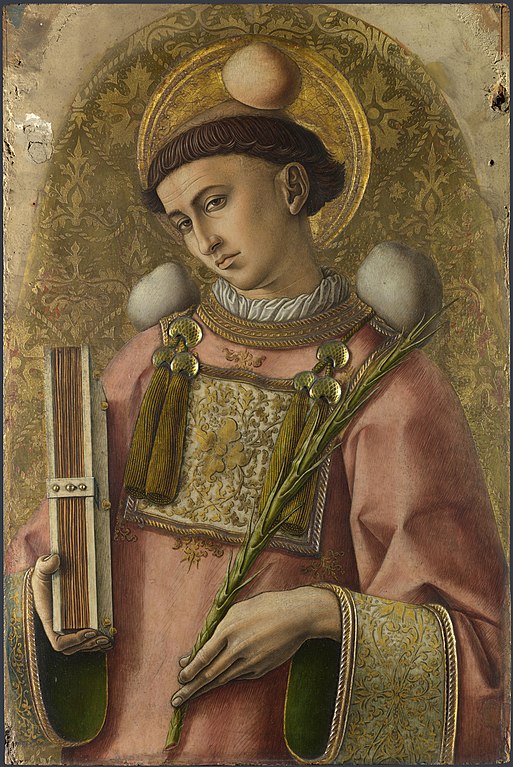
Source: National Gallery, London via Wikimedia Commons.
Public Domain in UK and US; may be restricted in other countries.
If you remember the Christmas carol Good King Wenceslas , you heard the name. Stephen was a deacon in the early Christian church who was accused of blasphemy and put on trial by Jewish authorities in Jerusalem. After a trial in which he denounced them, Stephen was stoned to death. One of the witnesses to the event was Saul of Tarsus, who later converted and is known today as the apostle Saint Paul. Stephen is considered the first martyr for the faith, the reason his feast day immediately follows the celebration of Jesus birth. All the major Christian congregations–Anglican, Catholic, Lutheran, Oriental Orthodox, and Eastern Orthodox–all venerate him as a Saint and celebrate the feast day (Western churches on 26 December, 27 Dec Orthodox, and 8 Jan Oriental Orthodox). In some countries (mainly Western Europe) it is a public holiday.
In the United Kingdom, Australia, Canada, and New Zealand it is celebrated as Boxing Day, a secular holiday that falls on the same day as Feast of Stephen. Traditionally it is the day in which servants and tradespeople receive the “Christmas box” from their employers. While that tradition may still hold true, it is either a second Christmas day for some or an extra shopping day (though in some countries it apparently is a day when a lot of returns to retailers takes place). It is also a major sports day as well.
Further Information
St. Stephen (Catholic Encyclopedia)
St. Stephen (Britannica)
Boxing Day (pauldenton.co.uk)
Shop for Christmas Holiday Movies on Amazon
(As an Amazon associate, I earn from qualifying purchases.)

